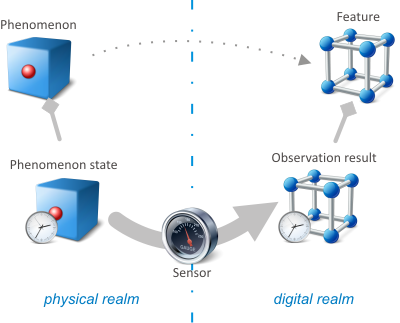

In order to cover a broad range of application areas and to make Redbex as universal as possible the software system is built on strong generic concepts that originate in the Sensor Web Enablement (SWE) standards issued by the Open Geospatial Consortium (OGC).
Redbex deals with recording, structuring, processing and presenting data that originates from natural phenomena. The digital representation of a natural phenomenon within Redbex is accomplished using features. The phenomenon's characteristics at a specific point in time are observed and stored in Redbex as observations of features. Devices used to observe a phenomenon's state are sensors.
Redbex does not limit the types of phenomena that can be managed, and allows easy integration of new types of phenomena. The actual data stored with features and observations is defined by the type of the feature and can range from simple numerical values to complex data structures.
|
Figure 1: Interaction between Phenomena, Sensors, Observations and Features.
Example 1: A real world phenomenon is the movement of a house (e.g. during construction works of a tunnel). This phenomenon will usually be monitored by some kind of sensor that observes the movement of a specific point of the house. In Redbex the specific point of the house observed by the sensor would be represented by a feature. The results of the observation done with the sensor would then be stored as observations for that feature. From this data Redbex can then calculate settlement, movement directions etc.
Example 2: A real world phenomenon is the turbidity of water at a specific sampling point, this phenomenon might be observed by hydrologists in course of an environmental monitoring program. The result of an observation would be a specific value out of a predefined vocabulary like no turbidity, light turbidity, medium turbidity, heavy turbidity. In Redbex the turbidity at that specific sampling point would be a feature, the results of the investigations done by the hydrologist (usually more than one over time) would be stored as observations.
Example 3: A real world phenomenon is the opinion of people on some political development. This phenomenon might get observed by conducting interviews with randomly selected persons. One interview usually consists of many questions, the answers to this questions are the result of an observation. In Redbex the opinion on the political development would be the feature, each conducted interview would be an observation.
The data that shall be stored for the feature in example 1 might also contain a location of the measurement point, some pictures of the house, a link to a cadastral register (somewhere on the internet) etc. Fore each observation in example 1 the data stored would be the date of the observation and the settlement (a numeric value in some unit). In example 2 the stored data for feature and observation would be totally different. The ability to handle different feature types and observations in one system is one of the key benefits of Redbex.

